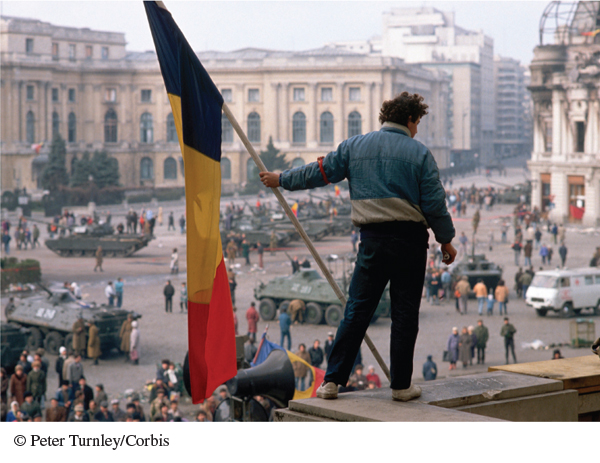A History of Western Society: Printed Page 1013
A History of Western Society, Value Edition: Printed Page 973
A History of Western Society, Concise Edition: Printed Page 1017
The Disintegration of the Soviet Union
As 1990 began, the tough work of dismantling some forty-
In February 1990, as competing Russian politicians noisily presented their programs and nationalists in the non-

Gorbachev responded by placing an economic embargo on Lithuania, but he refused to use the army to crush the separatist government. The result was a tense political stalemate that undermined popular support for Gorbachev. Separating himself further from Communist hardliners, Gorbachev asked Soviet citizens to ratify a new constitution that formally abolished the Communist Party’s monopoly of political power and expanded the power of the Congress of People’s Deputies. While retaining his post as party secretary, Gorbachev then convinced a majority of deputies to elect him president of the Soviet Union.
Despite his victory, Gorbachev’s power continued to erode, and his unwillingness to risk a universal suffrage election for the presidency strengthened his great rival, Boris Yeltsin (1931–2007). A radical reform Communist, Yeltsin embraced the democratic movement, and in May 1990 he was elected parliamentary leader of the Russian Soviet Republic. He boldly announced that Russia would put its interests first and declare its independence from the Soviet Union, broadening the base of the anticommunist movement by joining the patriotism of ordinary Russians with the democratic aspirations of big-
Opposed by democrats and nationalists, Gorbachev was also challenged by the Communist old guard. In August 1991 a gang of hardliners kidnapped him and his family in the Caucasus and tried to seize the Soviet government. The attempted coup collapsed in the face of massive popular resistance that rallied around Yeltsin. As the spellbound world watched on television, Yeltsin defiantly denounced the rebels from atop a stalled tank in central Moscow and declared the “rebirth of Russia.” The army supported Yeltsin, and Gorbachev was rescued and returned to power as head of the Soviet Union.
The leaders of the coup had wanted to preserve Communist power, state ownership, and the multinational Soviet Union; they succeeded in destroying all three. An anticommunist revolution swept Russia as Yeltsin and his supporters outlawed the Communist Party and confiscated its property. Locked in a personal and political duel with Gorbachev, Yeltsin and his democratic allies declared Russia independent, withdrew from the Soviet Union, and changed the country’s name from the Russian Soviet Republic to the Russian Federation. All the other Soviet republics also withdrew. Gorbachev resigned on December 25, 1991, and the next day the Supreme Soviet dissolved itself, marking the end of the Soviet Union. The independent republics of the old Soviet Union then established a loose confederation, the Commonwealth of Independent States, which played only a minor role in the 1990s.